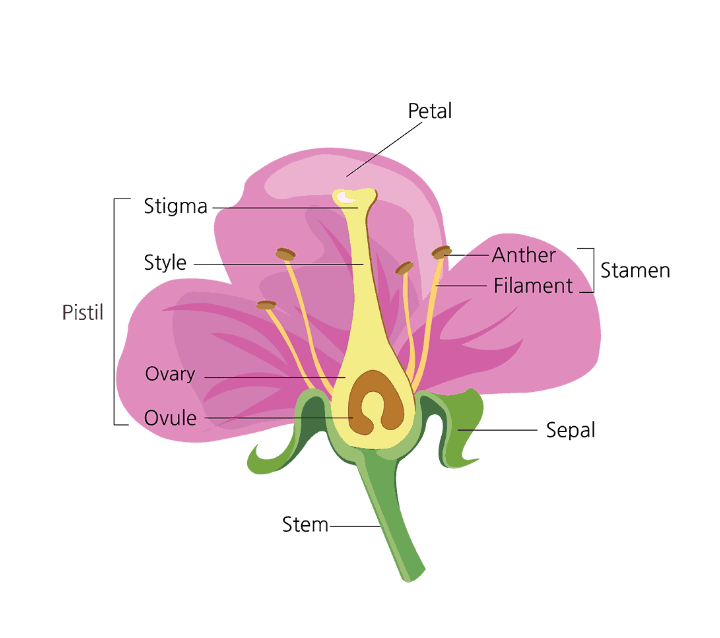
The flower is the reproductive system of the flowering plant. It is made up of different parts. On the flower is both the male and the female reproductive organs of the plant located. The male reproductive organ is called stamen ( which is made up of anther and filament). The anther houses the male reproductive cells called pollen grains. The female reproductive organ of the plant is called the pistil ( which is made up of three parts – stigma, style and ovary). The stigma receives the pollen grains which grows through the style to the ovary. Fertilization takes place in the ovary. The ovary houses the ovules. After fertilization, the Ovary develops to form the fleshy part of the fruit, while the ovules develops to form the seeds within the fruit.
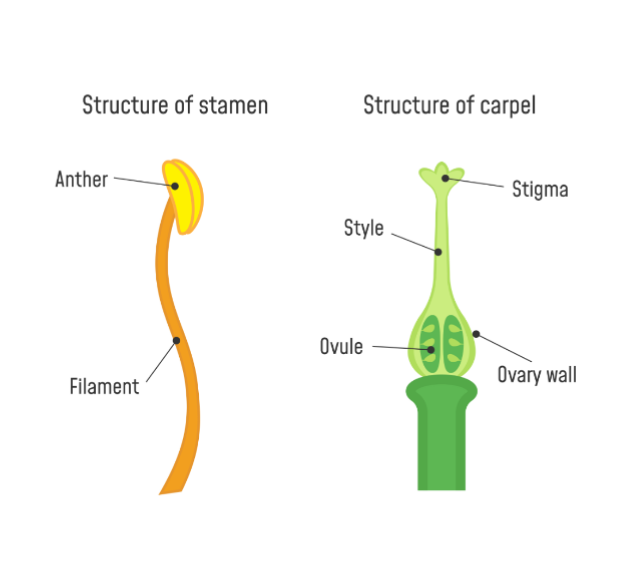
A seed is a mature ovules that consist of an embryo or an embryonic plant, a store of food and some protective covering.
The seed is often at the stage of rest or at low metabolic rate of activity. This period of rest prevails until suitable environmental condition is provided. Seeds are important for the following reasons :
1. Seeds are used for plant propagation
2. Seeds preserve plants during unfavorable growth condition
3. Seeds serve as a means of dispersal or distribution of some plants.
4. Seeds are a rich source of food. Animals and human beings consume them to get nutrients such as Carbohydrates, proteins, fat and oil, vitamins and minerals.
5. Seeds are raw material for industries. For example, mustard seed used to produce mustard oil. An important oil in medicine, phermacauticals and manufacturing of cosmetics.
TYPES OF SEEDS
There are primarily two types of seeds. The two types are:
1. Monocotyledonous Seed
2. Dicotyledonous Seed
STRUCTURE OF A MONOCOTYLEDONOUS SEED
A Monocotyledonous seed are seeds with only one cotyledon. The cotyledon surround the radicle and plumule. There is only one outer layering of the seed coat.
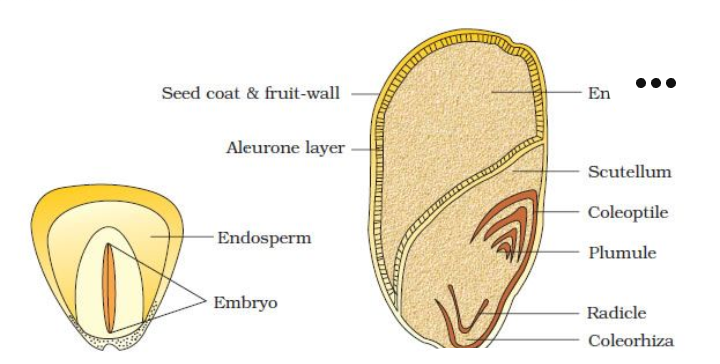
PARTS OF MONOCOTYLEDONOUS SEED
a. SEED COAT : Seed of monocot like cereals (e. g maize) has membranous seed coat which fuses with the fruit wall, called Hull.
b. ENDOSPERM : The endosperm stores food ( starch and proteins). Generally, monocotyledonous seeds are endospermic but some as in orchids are non-endospermic.
c. ALEURON LAYER : This is a outer proteinous layer that covers the endosperm, separating it from the embryo.
d. EMBRYO : The embryo is small and situated in a groove at one end of the endosperm. It function as a “starting point” for emergence of a new plant life: It contains the earliest forms of the plant’s roots, leaves, and stem, and it can sense whether the right conditions for growth are available.
e. SCUTELLUM : Scutella function in absorbing nutrients from the endosperm, transferring sugars and amino acids to the developing plant, and providing oil reserves. They can be identified by white patches on the seed.
f. EMBRYONAL AXIS : Plumule and radicle are the two ends of the axis. It helps the embryo to divide and form the stem of the plant after maturation. In dicots, the embryonic axis is connected by two cotyledons, but in monocots, it is connected by a single cotyledon
g. COLEOPTILE: The plumule are enclosed in a sheath called coleoptile. The coleoptile shield the plumule or young shoot.
h. COLEORHIZA : The radicle are enclosed in sheaths called coleorhiza. The coleorhiza shield the radicle or young root.
STRUCTURE OF A DICOTYLEDONOUS SEED
Unlike monocotyledonous seed, dicotyledonous seed has two cotyledons with the following parts:
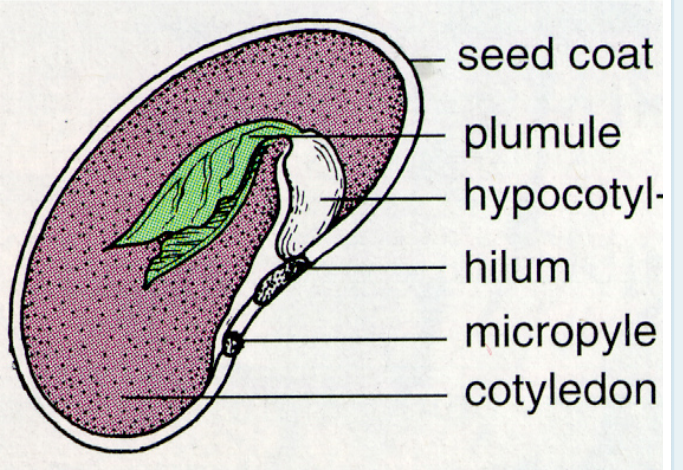
a. SEED COAT : This is the outermost covering of a seed. The seed coat has two layers, the outer testa and the inner tegmen.
b. HILUM : The hilum is a scar on the seed coat through which the developing seed attaches itself to the fruit.
c. MICROPYLE : It is a small pore present above the hilum.
d. EMBRYO : It consists of an embryonal axis and two cotyledons.
e. COTYLEDONS : Cotyledon is also called seed leaves. These are often fleshy and full of reserve food materials.
f. RADICLE AND PLUMULE : They are present at the two ends of the embryonal axis.
g. ENDOSPERM : In some seeds such as castor, the endosperm formed as a result of double fertilisation, is a food storing tissue. In plants such as bean, gram and pea, the endosperm is not present in the matured seed. They are known as non-endospermous
SEED GERMINATION
Germination is the process by which a plant grows from a seed into a seedling. Seeds remain dormant until planted and conditions are favorable for germination. Seed germination involves the resumption of growth or active metabolism in the seed which eventually results in a new plant. It involves the reactivation of metabolic processes within the seed and subsequent emergence of the radicle which develops into root and the plumule which grows into shoot.

The young plant developing from a seed is called a seedling. Germination is initiated under the following basic conditions
1. VIABLE SEED : When seeds are produced and dried, they remain viable for certain period of time. This viability period vary from plant to plant and from seed to seed. After which the embryo becomes dead. The embryo must be kept alive and be able to germinate into a normal seedling. Seed viability period depend upon storage conditions, vigour of parents, species etc.
2. The seed must be non domant: there must be no barrier to germination
3. The seed embryo must be quiescent: the seed is said to be quiescent when it can germinate immediately upon exposure to water and on the absence of any internal barrier to germination
There must be appropriate environmental factors or conditions for seed to germinate.
PROCESSES OF SEED GERMINATION
When a seed is sown into the soil, water is imbibed by the seed rapidly. This makes the cell protoplasm ( nucleus and cytoplasm) of the seed to swell. That is, the cell organelles in the seed becomes turgid. Also, the seed coat becomes permeable to gases, such as oxygen and carbon dioxide. The enzymes within the seed also becomes activated due to the imbibation of the water. This activate the metabolic processes within the seed. Germination then begin.
The radicle then protrude out of the seed and grows to become the root. In some seeds like cowpea seeds, the radicle breaks through the seed coat within hours while in seeds of crops like maize, the radicle will take few days to break through the seed coat and emerge. In crops with stony seed coat like oil palm, coconut, and walnut etc, emergence of radicle will take few months. The plumule then emerge from the seed carrying the cotyledon. The cotyledon can be either below the ground or carried out of the ground. When the cotyledon is carried above the ground, this is called epigeal germination and this type of germination can be found in dicotyledons like cowpea, groundnut, soybeans, etc. When the plumule elongate and does not carry the cotyledon above the ground, but only the epicotyl emerges, such germination is called hypogeal germination. Such germination is exhibited by monocotyledons such as maize, wheat, oil palm, grasses, etc.
REQUIREMENTS FOR GERMINATION
The following affect seed germination : varieties of seeds, stage of maturity, length of storage, prevailing environmental condition and growth of the plant.
1. VARIETIES OF SEEDS: Seed varieties corresponds to a population of plant seeds of a given species that has been selected and cultivated, often for millennia, in order to produce characteristics which meet man’s needs. There are different types of plants with varying types of seeds. Some seeds possess hard coat and some soft coat. Some seeds are capsulated in casings, while some seeds develop in the fleshy fruits. Also, seeds from the same plant species are produced in different sizes, colours, coat smoothness, quality, tastes and shapes etc.
2. SEED MATURITY: A seed is said to be matured when it is in such a stage that it can be separated from the mother plants without any impairment during subsequent germination. This is usually a stage when there is no further increase in the seed dry weight. This stage varies with plant species. While seeds of some species are capable of germinating into more completion of physiological maturity, others may fail to germinate due to dormancy even after seed dispersal.
3. LENGHT OF STORAGE: Storage condition can strongly affect seed germination. Maintaining seed viability for longer period is very essential to preserve the genetic integrity of seeds in storage.
Several factors like temperature, nature of the seeds, seed moisture content, relative humidity, etc influence the longevity of seeds during storage. Before storage, if the seeds are not properly dried, the high moisture content may reduce the seed viability by promoting fungal growth and insect development, thus, causing seed deterioration. Such deterioration could further result in declination of seed germination. Proper storage conditions, however, may effectively retain substantial viability in seeds over a considerable storage period. Depending on the duration and method adopted, drying and long-term storage may lead to considerable reduction in germination or death of the seed.
4. ENVIRONMENTAL CONDITION: Two environmental conditions are necessary for seed germination. The external conditions and the internal conditions. Environmental conditions are factors affecting seed germination. Such factors include water, oxygen and carbon dioxide, temperature, and light. These are external conditions. The internal conditions include: the growth chemicals and phytohormones.
a. WATER: Water is a basic need of all living organisms. It is required for seed germination since seed at maturity usually contain low moisture content and thus relatively inactive. This low moisture content cannot activate the metabolic processes in the seed required for germination. After seed extraction, seeds are processed to very low moisture content. When the seeds imbibe water, enzymes within the seeds are reactivated. These enzymes function in the release of essential metabolites which initiate growing of the seed, especially the embryo within it. Moisture content level in the seed also determine whether germination will occur or not. Different seeds start germinating at different moisture level. For example, cowpea requires about 50% seed moisture content to initiate germination unlike rice which require just about 30% and below. Excess moisture may prevent germination to occur.
b. OXYGEN AND CARBON DIOXIDE : Atmospheric air contains 21% oxygen, 0.03% carbon and 80% nitrogen. This is the ideal atmosphere for seed germination.
Respiration is essential for seed germination. Most seed germinate under aerobic condition while few germinate under anaerobic condition. For example, swamp rice can germinate under anaerobic condition. Seed germination requires ample supply of oxygen.
c. TEMPERATURE: The germination of seed is mainly a chemical reaction process. This chemical reaction depends on temperature. Seed germination require a temperature range between 37oC to 42oC. This temperature range is the best for optimization reactions of the enzymes required for growth. Such enzymes include diastase, lipase, and protease etc. These enzymes are involved in the breakdown of stored food in the seed for the release of energy for the growth of the embryo.
Some seeds like apple seeds require cold temperature (vernalization) to start germinating.
d. LIGHT: Seeds of various plant species require varying degrees of light intensity. Some seeds will germinate under high light intensity while some prefer low light intensity. Some germinate better in full light while others require darkness to germinate. Seeds germinate better under red light spectrum of 600 to 700mu. When the seed germinate, and leaves begins to form on the young seedlings, light is required for photosynthesis. But seedlings grow more vigorously in the dark rather in light
e. GROWTH CHEMICALS: Seed germination is also promoted or induced under certain growth chemicals. For example, 0.1 to 1% potassium nitrate promote growth. likewise the chemical called thiourea
f. PHYTOHORMONES :Phytohormones influences numerous physiological processes that occur in plant growth and development, and also in the plant death. For example, Gibberelline is known to promote growth like thiourea.
g. HARVESTING AND PACKAGING: Handling of seeds during harvesting and packaging can also affect germination. Proper handling of seeds during harvesting and packaging that prevent damages and breakage can increase the chances of seeds to germinate.
CAUSES OF POOR SEED GERMINATION
Poor seed germination can be caused by: i. OVERWATERING : Overwatering of planting media can cause the seed and plant not to have assess to sufficient oxygen.
ii. DEEP PLANTING: Planting seeds too deep into the soil can cause the seeds to use up all of their stored energy before reaching the soil surface. When the stored food are used up before emergence from the soil to start photosynthesizing, the germinating seed will rot in the soil.
iii. DROUGHT OR DRYNESS: Dry conditions means the seed or the plant will not have enough moisture to initiate the germination process. The dried soil becomes hardened up preventing the tender plumule and radicle to penetrate through the soil.
iv. SEED COAT: Some seed possess hard seed coats that makes it difficult for water and oxygen to get through for kick start the germination process unless the coat breaks down. Soaking or scratching the seeds will help break down the seed coat etc.
v. INSUFFICIENT TEMPERATURE : Some seeds need to be exposed to proper temperatures. Seeds like Apple seed will not germinate unless the soil is at cold temperature for some period of time.
SEED DORMANCY
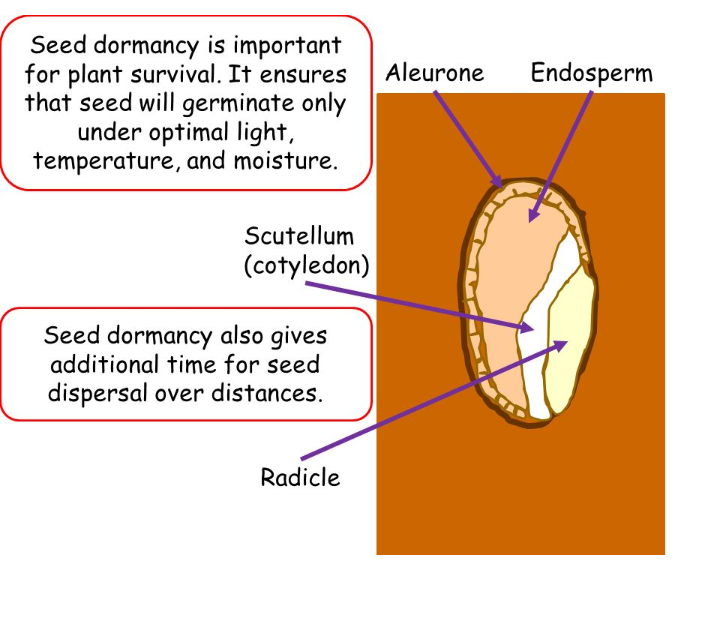
Dormancy means lack of seed to germinate even when seed imbibe water and all environmental factors which should support germination are in place. This means that under favourable conditions, the seeds will not germinate. Dormancy is characterized by partial metabolic arrest, which is hormonally controlled by endogenous phytohormones.
Long domesticated plant species do show less seed dormancy than recently domesticated and wild species.
Seed dormancy has advantages and disadvantages. One of the advantage is that it prevent pre- harvest sprouting or pre- germination.
The disadvantages are failure of seed to germinate, in some cases, dormancy of seeds may last for many years,
TYPES OF DORMANCY
There are different types of seed dormancy. They include: seed coat induced dormancy, mechanical dormancy, chemical dormancy, morphological dormancy, physiological dormancy or embryo dormancy
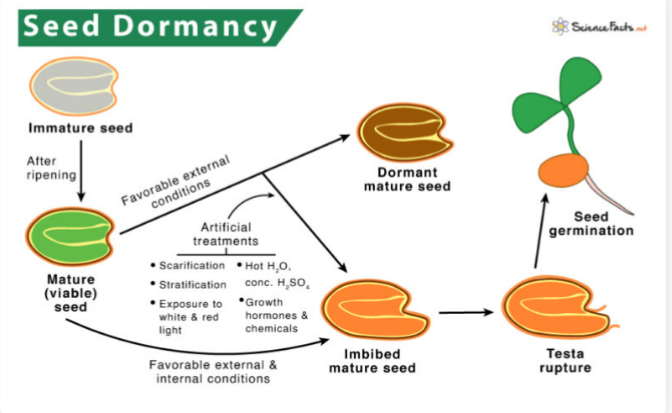
1. SEED COAT INDUCED DORMANCY : Seed coat induced dormancy is common in legumineous species and some grasses. It is due to impermeability of the seed coat of the plant species to water and necessary gaseous exchange. In the case of legumes, it is more of impermeability to water. While in grasses, it is more of impermeability to gases. Dormancy due to hard seed coat depends on the genetic nurture of the seed, the cultivar and the environmental conditions prevailing at fruiting and the maturation period of the seed. For example, when the temperature is high and the seed drys up with ripening, the seed coat may become impermeabile, preventing water and gas to permeate through the seed covering.
HOW TO OVERCOME SEED COAT INDUCED DORMANCY
To soften seed coats in preparation for germination, various methods or practices can be employed.
a. Practices such as mechanical abrasion or subject the seeds to varying temperatures, such as freezing and thawing.
b. Exposure of seeds to microbs to help overcome impermeability of seed coat to water and gases. c. Also, when livestock consume seeds of crops and the seeds passes through the gastrointestinal tract of the animal, seed dormancy can be overcome.
d. Scarification: Seeds with hard coat are often scarified before planting to permit faster and more uniform water uptake and germination.
METHODS OF SCARIFICATION
There are two methods of scarification.
i. Mechanical scarification
ii. Chemical scarification
i. MECHANICAL SCARIFICATION : Mechanical scarification is carried out by a machine that rotates the seed over a sharp internal prostrusions to create a scare on the seed inorder to break dormancy. Also, a wrough surface such as file or sand paper can be used for scarification. The hard seeds coat would be robbed over the wrough surface.
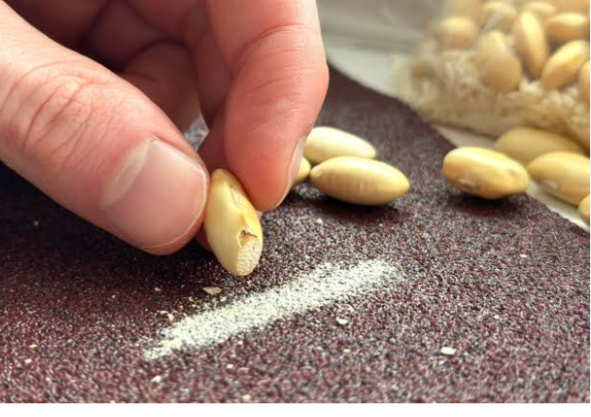
ii. CHEMICAL SCARIFICATION : This is the use of chemicals to break dormancy. Such chemicals include acetone, hydrochloric acids, sodium hydroxide and alcohol. Note that both mechanical and chemical scarifications can be combined to break seed dormancy.
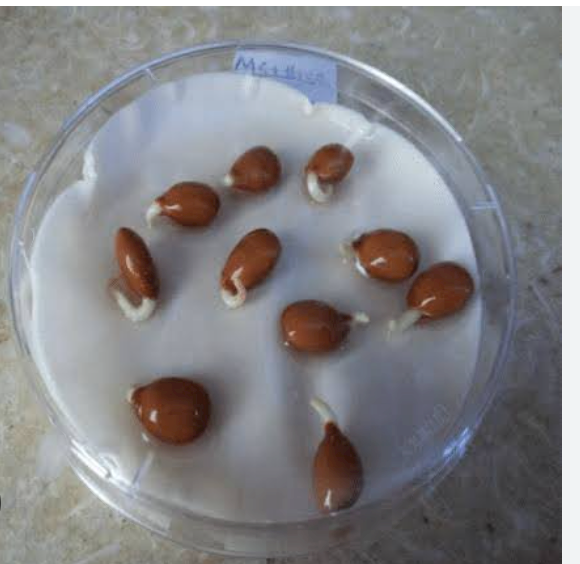
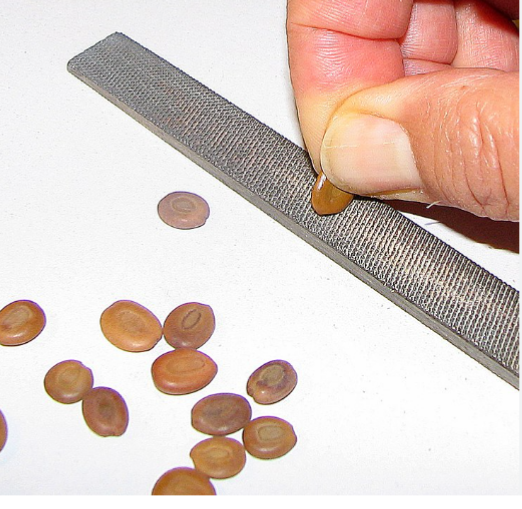
e. HOT WATER OR ICE TREATMENT : Hot water or ice can be used to break dormancy. They can be used to remove the waxy layer and other substances preventing seed germination.
2. MECHANICAL DORMANCY : This type of dormancy is due to the hardness of the seed coat to the extent that the embryo is prevented from expanding. Prevention of the embryo from expansion together with other factors can delay germination. Once the embryo absorb water and expand, the seed coat will rupture. Hard shelled seeds can delay germination.
HOW TO OVERCOME MECHANICAL DORMANCY
The same methods used for overcoming Seed coat induced dormancy is the same methods used to overcome mechanical dormancy.
3. CHEMICAL DORMANCY : Some chemicals stored in the seed matrix can inhibit seeds from germinating. Such chemicals include phenols and abscisic acids. Fleshy fruits are known to inhibit seed germination. As long as the fleshy fruit remain intact, the seeds within it will not germinate.
4. MORPHOLOGICAL DORMANCY : This type of dormancy is the one caused when the embryo is not fully developed during ripening. Therefore, for the seeds to germinate, the embryo must be fully developed before separation of the fruit from the mother plant.
TYPES OF MORPHOLOGICAL DORMANCY
There are two types of morphological dormancy. They include:
i. Rudimentary embryo : This is common among ornamental plants
ii. Undeveloped embryo: This is found in crops like carrot, tropical monocotyledons and some ornamental plants
5. PHYSIOLOGICAL DORMANCY OR EMBRYO DORMANCY: Embryo in seeds can become physiologically immature. This will cause seed dormancy. This dormancy is common among woody plant species and grasses. It can be overcome by proper storage in a dry condition.
6. DORMANCY DUE TO PHYTOHORMONES : Endogenous chemicals called phytohormones can also cause dormancy, especially abscisic acids and Ethylene. Other chemicals like hydrogen cyanide and ammonium are natural germination inhibitors that can inhibit germination.
